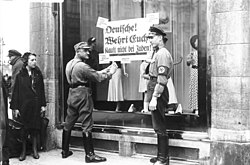This article needs additional citations for verification .(February 2023) |
| |||||
| Decades: | |||||
|---|---|---|---|---|---|
| See also: | Other events of 1933 History of Germany • Timeline • Years | ||||

Events in the year 1933 in Germany.
This article needs additional citations for verification .(February 2023) |
| |||||
| Decades: | |||||
|---|---|---|---|---|---|
| See also: | Other events of 1933 History of Germany • Timeline • Years | ||||

Events in the year 1933 in Germany.




The pivotal nature of 1933 in Germany has led to it being a commonly used analogy in modern politics. The 1933 power grab by the Nazi party has been associated with modern political events, particularly the Presidency of Donald Trump in the United States and the 2023 Israeli judicial reform (eventually passed in 2025). [5] [6] [7] [8] Professor Daniel Blatman, a historian of the Holocaust at the Hebrew University of Jerusalem, stated in a February 2023 interview with Haaretz that the situation surrounding the proposed judicial reform at the time, "Really Does Recall Germany in 1933", and referred to the more extreme ministers of the government as "neo-Nazi". [8] Israeli journalists and others repeated or elaborated on Blatman's compassion. [9] [10] In a 2017 essay titled "The Reichstag Fire Next Time: The coming crackdown" Russian-American journalist M. Gessen wrote, "The Reichstag fire, it goes almost without saying, will be a terrorist attack, and it will mark our sudden, obvious, and irreversible descent into autocracy". [11]